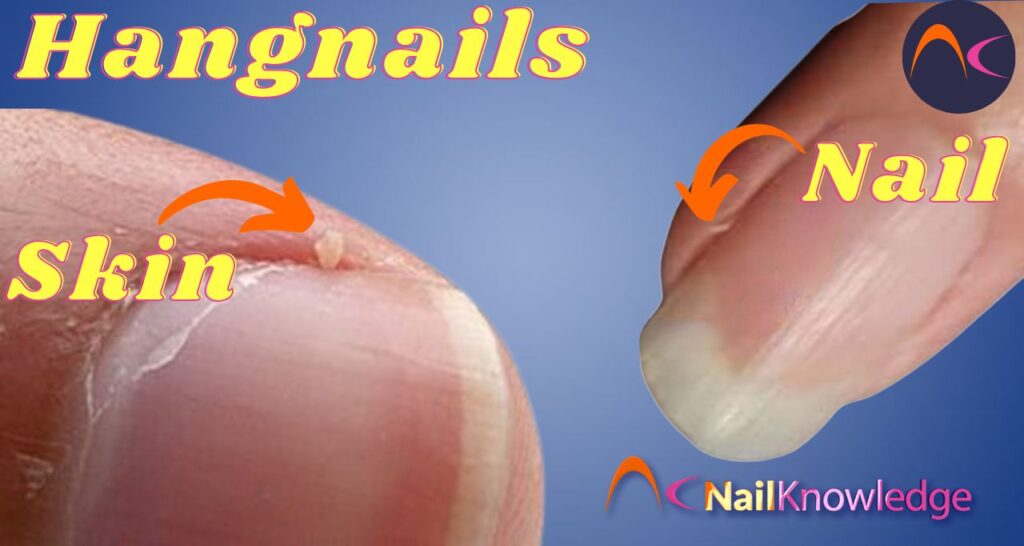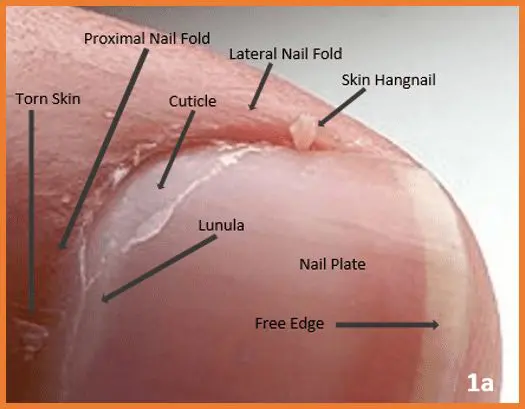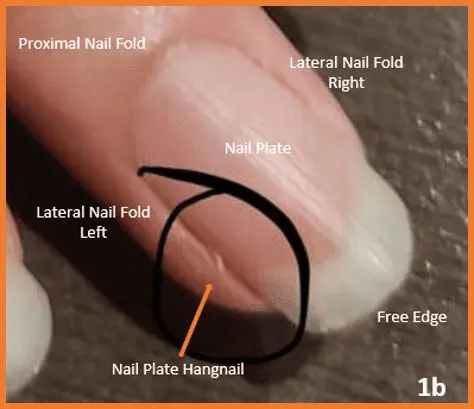How Can We Help?

Hangnails
12.0k Views
What are hangnails and what causes them?
Hangnails are either a small spike of nail within the lateral nail folds or, more commonly, a torn piece of skin adjacent to a fingernail or toenail.
It used to be the case that we defined a hangnail as a piece of skin but a reanalysis of the nail unit shows that the nail plate can also splinter at the lateral nail folds creating a hanging splinter of nail. So now we have 2 definitions of a hangnail.
** Definition A: ** Is a bit of torn skin that is lifting away from a nail fold. (Picture that annoying piece of skin that sometimes just dangles there, begging to be pulled off)
** Definition B: ** A splintered nail plate in the lateral nail fold (around the paronychium cup) that, as the nail grows, presses into the flesh or protrudes, when you ‘wiggle’ it, it feels hard, a bit like a loose tooth. The same thing can occur in the LNF of the toenail, it’s caused by improperly trimming, bad efile technique or cutting too deeply.
** Symptoms: ** In both cases, while many of us have had the misfortune of experiencing a hangnail firsthand, what’s crucial is recognizing the discomfort they bring and differentiating between the two.
When (either of) these are pulled out, bleeding, swelling, pain and infectious inflammation can occur. Remember the sharp sting after accidentally yanking it? Yep, that’s the start of any one of those problems.
In 1922 The British Medical Journal wrote about hangnails. “The irritation they cause is out of all proportion to their size; they are always unseemly and in the case of persons who use their hands that come into contact with infectious materials they may actually be dangerous.” (Until their introduction in 1889 gloves were not commonly used and the first disposable latex medical gloves were produced in 1964 by the Ansell Rubber Company)
What causes a hangnail?
The main causes of hangnails include aggressive manicure techniques, improper use of professional nail products, skin dryness, cold temperatures, hyperkeratosis in the nail bed and thick skin around the nail plate. Hangnails that appear a few days after a nail treatment can also be a sign that a poor manicure technique was used.
- Aggressive Manicure Techniques: Ever been a little too enthusiastic with your manicure? Overzealous nail grooming can be a hangnail’s best friend!
Removing the Stratum Corneum layer around the Lateral Nail Folds with an efile will cause the lateral nail folds to defend itself with a hard extra keratinized layer of skin, which can also cause the nail plate to splinter as it travels along the lateral nail folds. You could also, albeit unintentionally, cause a splinter on the nail plate with your efile bit.
It’s important to remember that the nail plate is in perpetual motion 24/7 as long as the nail matrix continues to generate new nail plate cells. Similarly, our skin undergoes continuous regeneration, making it a dynamic and constantly renewing organ. This ongoing cellular activity is essential for maintaining the health and integrity of both our nails and skin.
Improper Use of Professional Nail Products:
Not all products are born equal, and misusing them can lead to those dreaded hangnails. Always ensure you’re using products appropriately.
- After the use of cuticle removers take care to wash hands and nails with soap & water to deactivate the active ingredients. Not doing so will give the cuticle remover a chance to continue to work causing or the nail plate to fracture along its edge in the lateral nail fold or cause the lateral nail fold to dry out causing fractures in the skin that could become a safe haven for a paronychia infection.
Environmental Factors: Think about those chilly winter days where your skin feels as dry as the Sahara.
- Cold weather can be a major culprit behind those painful hangnails. This is possibly due to the contraction of our skin during cold weather, also nail plates that have been in water continuously will contract as the excess water evaporates causing the nail plate itself to contract, if there is a small fracture present in the nail plate this will enlarge during the contraction causing the nail plate to fracture even more or splinter.
Skin Conditions: Conditions like relative hyperkeratosis in the nail bed can make the skin around the nails thick and more susceptible to hangnails. Other skin conditions such as Lichen Planus, Alopecia Areata, Psoriasis, Eczema as well as Edema can cause Transepidermal Water Loss (TEWL) or Transonychial Water Loss (TOWL) – a healthy nail has about an 18% natural water content that can lead to hangnails.
Who does hangnails affect?
Anyone, especially people who work a lot with their hands or work with their hands in water. Gardeners, carpenters, or, well, anyone who often gets their hands dirty, wet, or exposed to harsh conditions might find hangnails to be frequent, unwelcome guests. Office workers suffer from loose skin around the nail unit usually triggered by paper cuts.
It’s also the case that wearing protective gloves made from rubber, latex or nitrile can cause a build-up of fluid around the nail unit if the gloves are not changed regularly – we recommend every 30 mins or sooner if your hands ‘feel wet’ inside the gloves.
Washing your hands well and applying a good quality nail & skin oil and or lotion before reapplying your gloves will help too.
How can nail technicians help with hangnails?
Hangnails can be avoided with the proper manicure technique and continuous nail and skin care & maintenance. When skin is rough, hard or dry, moisturising creams, oils & lotions should be recommended to the client to prevent the chances of it happening or reoccurring. Nail technicians aren’t just about making nails look pretty; they’re the unsung heroes when it comes to hangnail care.
Prevention: The right manicure technique is half the battle won. With gentle handling and the correct tools, hangnails can be kept at bay.
A hangnail caused by a splinter of the nail plate can be treated by nail technicians with a gentle and attentive manicure.
It’s not generally known, but experience in the salon shows that adhering a hangnail back onto a nail plate with artificial nail product & a small piece of silk, taking care not to touch the skin will relieve the symptoms and applying a good quality oil & moisturising lotion will improve the flexibility and quality of the nail plate (helping to stop the hangnail reoccurring). Never use nail glue to do this as it contains allergens that could trigger an allergic reaction.
In the salon we may be able to help in a more practical way. In the world of podiatry, we use composite to create nail braces, composite is effective because as it cures it shrinks. This shrinkage (gently) lifts the nail plate out of the paronychium cup that the nail plate lays in, reducing the pressure of the nail plate in the lateral nail fold. When applying this technique in the hand nail salon it’s important to remember the importance of nail unit maintenance and care with a good quality oil and lotion. The flexibility of the nail plate will help relieve the pressure and or pain that a hangnail splinter or hangnail skin causes as the nail continues to grow.
Hangnails that are torn skin
This can be exceptionally painful and if the patch of skin is particularly large we used to cut it off with clippers or scissors. According to an article published in October 2019 (see ref) a simpler and more effective way of dealing with a large skin hangnail is gluing it back into place with surgical glue. This provides instant relief. Never use nail glue to do this as it contains allergens that could trigger an allergic reaction.
Never tear or bite dry skin off, choosing the lesser of 2 evils, its better to remove it with sharp, clean nail scissors.
Recommendations for Clients
Regular washing of the hands with soap & water and the use of good quality nail & skin oils or lotions containing urea can keep hangnails from making a reappearance and or reduce any pain.
For the DIY folks out there
Fear not! There are ways to tackle hangnails right at home.
Moisturization: Dryness is a hangnail’s playground and Nr 1 enemy of the nail unit. Realizing the importance of and keeping the skin around the nails moisturized can be a game-changer.
Avoiding Damage: Resist the urge to pull or bite hangnails. When in doubt, use sterilized clippers or sterilized sharp nail scissors to gently trim them.
When to seek professional help
Signs of Infection: Redness, swelling, color change & or pus? It’s time to seek help.
Persistent Problems: If hangnails are a recurring issue despite your best efforts, it might be time to see a dermatologist.
Other Complications: Sometimes, what looks like a simple hangnail might be more. If you notice any unusual symptoms, better to get it checked!
FAQs:
1. Can hangnails lead to infections?
* Yes, if left untreated or if improperly handled, hangnails can lead to infections.
2. How often should I moisturize my hands to prevent hangnails?
* Moisturizing 4-5 times daily or whenever your hands feel dry is a good rule of thumb.
3. Can I use any oil?
* While many oils can be beneficial, olive oil, apricot oil or coconut oil are commonly recommended for nail care and there are some amazing nail & skin oils in the professional market.
4. Are there any specific creams or oils to prevent hangnails?
* Look for creams with ingredients like urea, allantoïne, hyaluronic acid or ceramides which provide deep hydration.
5. How can I tell if my hangnail is infected?
* Signs of infection include redness, swelling, warmth, color changes and/or pus around the hangnail.
Contra indications for removal of hangnails:
1: Chemotherapy and or immunotherapy can cause serious edema in the hands and or feet that forces the nail plate out of the paronychium cup, this is enough to cause serious hangnail problems with likelihood of infection being a very real possibility – Please refer these clients to a medical hand specialist, oncology hand specialist, the leading nurse in their treatment team, a medical practitioner or their GP. DO NOT apply artificial nail products.
2: Clients suffering from Diabetes should not be treated in a Nail Salon without expertise or a specialism qualification in Diabetes. DO NOT apply artificial nail products and never use an efile to ‘polish’ the skin or to remove dry or keratinized skin, infections for these clients can have serious consequences such as amputation or sepsis and should be taken very seriously. When in doubt refer these clients to a medical hand specialist, the leading nurse in their treatment team, a medical practitioner or their GP.
3: Soaking hands & nails in solutions for any longer than 30 seconds can work to perpetuate hangnails in the hand and or feet. Nails and Skin emersed in water for longer will absorb that water and swell after which the water evaporates and any cracks in the skin or nails will worsen as the nails and skin shrink back to their normal size. Rinsing and washing of hands is always good as long as you replenish any lost oils and use a hand lotion.
Conclusion:
Hangnails might be tiny, but they sure pack a punch in the discomfort department. By understanding their causes and seeking the right treatments, you can keep your hands hangnail-free or at least hangnails under control. And remember, nail technicians are there to help, not just glam up your nails. So, next time you spot a hangnail, you know what to look for and how to deal with it.
Image Gallery


Article References
REF: Kaur I, Jakhar D, Misri R. Hangnails: Pediatr Dermatol. 2020 Jan;37(1):255-256. doi: 10.1111/pde.14008. Epub 2019 Oct 20. PMID: 31631394.
